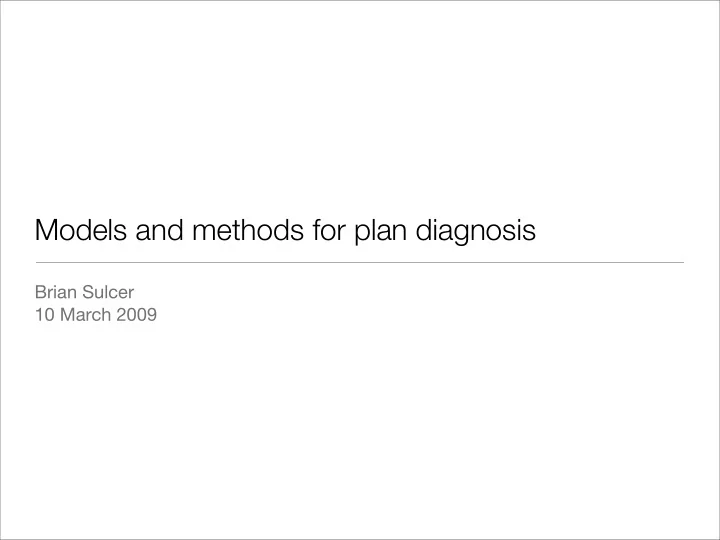

Models and methods for plan diagnosis Brian Sulcer 10 March 2009
Source • Roos, N & Witteveen, C. (2007). Models and methods for plan diagnosis. Autonomous Agents and Multi-Agent Systems 19(1):30-52
Model-based plan diagnosis • plan performed by some agent(s) is considered as a system to be diagnosed • plan execution can be monitored by making partial observations of plan states • compare observed states with predicted states based on normal plan execution • deviations between observed and predicted states explained by qualifying a subset of plan states as behaving abnormally
Definitions • state: assignment of values to variables • partial state: state assignment in which some variables are unassigned • partial state ordering: partial states can be ordered with respect to their information content • compatibility: states are compatible if they could characterize the same state of the world • information fusion: compatible states can be combined to form a new partial state
Actions, plan operators and plan steps • actions: activity that changes some part of the world; considered the only source of state changes • plan operator: formal definition of action in a plan; maps partial state to partial state • plan step: specific instance of a plan operator applied to a specific partial state
Plans and plan execution • a plan consists of a set of operators, a set of steps and a partial order between plan steps (execution order) • steps take unit time to execute and are executed at the earliest possible time step according to the execution order • no plan step will affect inputs of any other step occurring at the same time • there is no overlap in the variables affected by plan steps executing at the same time
Qualifications, predictions • health modes: set of possible modes of malfunction of a plan step, including normal operation; includes predicted output for each mode • qualified plan: plan plus set of step qualified as abnormal • resulting state from execution of a step is undefined if • the step is qualified as abnormal • one or more of the inputs to the step are undefined
Observations and diagoses • observation: pair of partial states resulting at times t and t’ such that t < t’ • diagnosis is performed by comparing this observation with the predicted state at t’ following the state at t • if the predicted state is not compatible with the observed state, then execution has gone wrong • plan diagnosis: a qualification such that the predicted state under the qualification is compatible with the observed state
Preferred diagnoses • subset minimal plan diagnosis: no smaller subsets can be used as diagnosis • minimum plan diagnosis: assigns the the minimal number of abnormal steps • prefer diagnoses with smaller number of undefined variables (precision) • predictive power: the number of predicted variable values that are compatible with the observed values • the maximum predictive power of any diagnosis is the predictive power of the null diagnosis (normal operation)
Preferred diagnoses • maxi-diagnosis (maximally informative): diagnosis such that there exists no diagnosis with greater predictive power • mini-maxi diagnosis (minimal maximally informative): maxi-diagnosis such that there exists no maxi-diagnosis that is a subset • finding minimum diagnoses is NP-hard (reducible in polynomial time to the minimum cover problem)
Generating maxi-diagnois • create the disagreement set (the set of variables that are defined in both the predicted and observed state, but with different values) • working backward in time, identify the plan step that effects variables in the disagreement set, add it to the diagnosis and remove those variables from the disagreement set • the diagnosis now contains the latest steps that could have caused all the disagreements
Distributed plans and mini-maxi diagnoses • assume partitioning of the plan steps among agents • agents label their own steps with preliminary labels, then propagate labels to other agents and resolve final labelings
Label setting phase • steps producing variables in the disagreement set are labeled faulty or maybe faulty, depending on their dependence on prior step output • steps not producing variables in the disagreement set are labeled healthy or maybe healthy, depending on their dependence on prior step output • steps are labeled ‘no’ if they are not enabled within the observation time window
Label propagating phase • agents retrieve preliminary labels from others and use them to resolve all maybe labels labels of current label definite label predecessors ∃ f mf/mh no ∃ no mf/mh no ∃ mf mf/mh no ∀ h mh h ∀ h mf f
Conclusions • the simple framework presented allows diagnosis using partial observations of plan execution • minimum diagnosis difficult, but minimal maximum informative diagnosis can be found efficiently • mini-maxi diagnosis can be found efficiently in a distributed environment
Recommend
More recommend